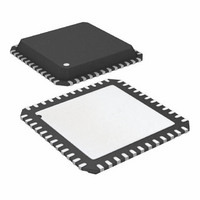ADF7020BCPZ Analog Devices Inc, ADF7020BCPZ Datasheet - Page 25

ADF7020BCPZ
Manufacturer Part Number
ADF7020BCPZ
Description
IC TX FSK/ASK ISM BAND 48LFCSP
Manufacturer
Analog Devices Inc
Datasheet
1.ADF7020BCPZ.pdf
(48 pages)
Specifications of ADF7020BCPZ
Design Resources
Low power, Long Range, ISM Wireless Measuring Node (CN0164)
Frequency
431MHz ~ 478MHz and 862MHz ~ 956MHz
Data Rate - Maximum
200kbps
Modulation Or Protocol
ASK, FSK
Applications
Data Transfer, RKE, Remote Control/Security Systems
Power - Output
-16dBm ~ 13dBm
Sensitivity
-119dBm
Voltage - Supply
2.3 V ~ 3.6 V
Current - Receiving
19mA
Current - Transmitting
26.8mA @ 10dBm
Data Interface
PCB, Surface Mount
Antenna Connector
PCB, Surface Mount
Operating Temperature
-40°C ~ 85°C
Package / Case
48-LFCSP
Data Rate
200Kbps
Supply Voltage Range
2.3V To 3.6V
Logic Case Style
LFCSP
No. Of Pins
48
Operating Temperature Range
-40°C To +85°C
Msl
MSL 1 - Unlimited
Termination Type
SMD
Operating Temperature (min)
-40C
Operating Temperature (max)
85C
Operating Temperature Classification
Industrial
Product Depth (mm)
7mm
Product Length (mm)
7mm
Operating Supply Voltage (min)
2.3V
Operating Supply Voltage (typ)
2.5/3.3V
Operating Supply Voltage (max)
3.6V
Lead Free Status / RoHS Status
Lead free / RoHS Compliant
For Use With
EVAL-ADF7020DBZ3 - BOARD EVAL ADF7020 433-445MHZEVAL-ADF7020DBZ2 - BOARD EVAL ADF7020 862-870MHZEVAL-ADF7020DBZ1 - BOARD EVAL ADF7020 902-928MHZ
Memory Size
-
Lead Free Status / Rohs Status
Compliant
Available stocks
Company
Part Number
Manufacturer
Quantity
Price
Part Number:
ADF7020BCPZ
Manufacturer:
ADI/亚德诺
Quantity:
20 000
APPLICATIONS INFORMATION
LNA/PA MATCHING
The ADF7020 exhibits optimum performance in terms of
sensitivity, transmit power, and current consumption only if its
RF input and output ports are properly matched to the antenna
impedance. For cost-sensitive applications, the ADF7020 is
equipped with an internal Rx/Tx switch that facilitates the use
of a simple combined passive PA/LNA matching network.
Alternatively, an external Rx/Tx switch, such as the Analog
Devices ADG919, can be used. It yields a slightly improved
receiver sensitivity and lower transmitter power consumption.
External Rx/Tx Switch
Figure 32 shows a configuration using an external Rx/Tx switch.
This configuration allows an independent optimization of the
matching and filter network in the transmit and receive path
and is, therefore, more flexible and less difficult to design than
the configuration using the internal Rx/Tx switch. The PA is
biased through Inductor L1, while C1 blocks dc current. Both
elements, L1 and C1, also form the matching network, which
transforms the source impedance into the optimum PA load
impedance, Z
Z
output power, the frequency range, the supply voltage range,
and the temperature range. Selecting an appropriate Z
helps to minimize the Tx current consumption in the
application. Application Note AN-767 contains a number of
Z
conditions, however, it is recommended that a suitable Z
value be obtained by means of a load-pull measurement.
Due to the differential LNA input, the LNA matching network
must be designed to provide both a single-ended-to-differential
conversion and a complex conjugate impedance match. The
network with the lowest component count that can satisfy these
requirements is the configuration shown in Figure 32, which
consists of two capacitors and one inductor.
ANTENNA
Rx/Tx – SELECT
OPT
OPT
_PA depends on various factors, such as the required
_PA values for representative conditions. Under certain
ADG919
Figure 32. ADF7020 with External Rx/Tx Switch
OPT
_PA.
OPTIONAL
OPTIONAL
(SAW)
LPF
BPF
C
C
C1
B
A
V
Z
Z
BAT
Z
L
IN
IN
OPT
A
L1
_RFIN
_RFIN
_PA
PA_OUT
RFIN
RFINB
ADF7020
OPT
LNA
OPT
_PA
PA
_PA
Rev. B | Page 25 of 48
A first-order implementation of the matching network can be
obtained by understanding the arrangement as two L type
matching networks in a back-to-back configuration. Due to the
asymmetry of the network with respect to ground, a compromise
between the input reflection coefficient and the maximum
differential signal swing at the LNA input must be established.
The use of appropriate CAD software is strongly recommended
for this optimization.
Depending on the antenna configuration, the user may need a
harmonic filter at the PA output to satisfy the spurious emission
requirement of the applicable government regulations. The
harmonic filter can be implemented in various ways, such as a
discrete LC pi or T-stage filter. Dielectric low-pass filter compo-
nents, such as the LFL18924MTC1A052 (for operation in the
915 MHz and 868 MHz band) by Murata Manufacturing, Co.,
Ltd., represent an attractive alternative to discrete designs.
AN-917 describes how to replace the Murata dielectric filter
with an LC filter if desired.
The immunity of the ADF7020 to strong out-of-band interference
can be improved by adding a band-pass filter in the Rx path.
Apart from discrete designs, SAW or dielectric filter components,
such as the SAFCH869MAM0T00 or SAFCH915MAL0N00,
both by Murata, are well suited for this purpose. Alternatively,
the ADF7020 blocking performance can be improved by
selecting the high linearity mode, as described in Table 5.
Internal Rx/Tx Switch
Figure 33 shows the ADF7020 in a configuration where the
internal Rx/Tx switch is used with a combined LNA/PA
matching network. This is the configuration used in the
ADF7020-XDBX
slight performance degradation of 1 dB to 2 dB caused by the
internal Rx/Tx switch is acceptable, allowing the user to take
advantage of the cost saving potential of this solution. The
design of the combined matching network must compensate for
the reactance presented by the networks in the Tx and the Rx
paths, taking the state of the Rx/Tx switch into consideration.
ANTENNA
BPF OR LPF
OPTIONAL
Figure 33. ADF7020 with Internal Rx/Tx Switch
evaluation boards. For most applications, the
C1
C
C
A
B
V
BAT
L1
L
Z
Z
Z
A
OPT
IN
IN
_RFIN
_RFIN
_PA
PA_OUT
RFIN
RFINB
ADF7020
ADF7020
LNA
PA














